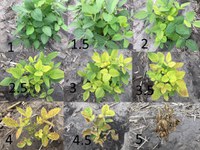NDSU Releases Soybean Variety IDC Scores
(Click the image below to view a high-resolution image that can be downloaded)
Field choice and selecting a variety with tolerance to iron-deficiency chlorosis (IDC) are the most important management decisions producers will make in avoiding or reducing the negative yield effect of chlorosis, says Hans Kandel, North Dakota State University Extension agronomist.
According to Kandel, IDC was prevalent in many soybean fields in eastern North Dakota and northwestern Minnesota during the 2018 growing season.
During the early summer of 2018, the NDSU soybean breeding program tested 201 Roundup Ready and Xtend soybean varieties, as well as 43 conventional and Liberty Link varieties for IDC tolerance. The test results are available at https://www.ag.ndsu.edu/varietytrials/soybean.
The results are based on field studies conducted at two locations with a past history of IDC. Visual ratings were made on a 1 to 5 scale, with 1 representing no chlorosis and 5 being the most severe chlorosis. Ratings were taken twice, at two different growth stages.
“Producers can use the NDSU data to select the most appropriate IDC-tolerant soybean variety for a field with known IDC issues,” says Kandel.
Soybean varieties have genetic differences for the expression of IDC symptoms, and some have tolerance to IDC. No soybean variety is immune to chlorosis, but large differences in yellowing and subsequent plant stunting occur between the most tolerant and most susceptible varieties.
Although most soils in North Dakota have sufficient iron, under certain conditions such as high carbonates, high pH, excess moisture, cool temperatures or high nitrate content, soybean plants are unable to take up sufficient iron from the soil. This often results in soybean fields with yellowing and reduced plant growth.
Plant leaves with IDC symptoms are yellow with green veins. Yellowing, browning and stunting of the plants during the early vegetative stages will result in less photosynthesis in these plants, compared with healthy green plants, resulting in reduced soybean yields.
The yellowing of the leaves usually becomes pronounced when the plants reach the two- to seven-trifoliate leaf stages. Soybean plants may grow out of IDC symptoms and turn green at the end of the vegetative growth stages but due to the early season IDC, yields still will be reduced.
The North Dakota Soybean Council provided funding for the studies.
NDSU Agriculture Communication – Aug. 23, 2018
| Source: | Hans Kandel, 701-231-8135, hans.kandel@ndsu.edu |
|---|---|
| Source: | Ted Helms, 701-231-8136, ted.helms@ndsu.edu |
| Editor: | Kelli Anderson, 701-201-6136, kelli.c.anderson@ndsu.edu |


